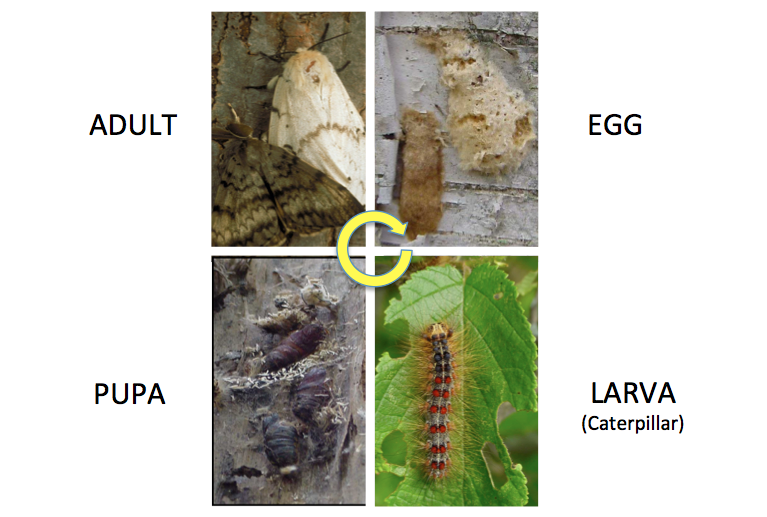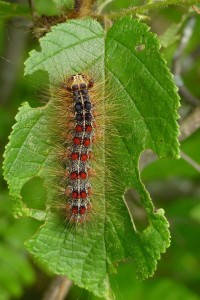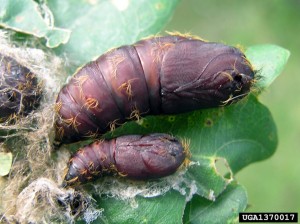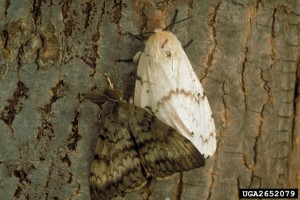
Spongy moth (Lymantria dispar) has four distinct developmental stages: egg, larva, pupa, and adult. Each life stage looks and behaves very differently from the other stages. Eggs and pupae appear lifeless, but undergo dramatic changes internally. Larvae eat and accumulate fat that is used when they are adults to find a mate and reproduce.
Eggs: The overwintering stage
Eggs are laid in August and the embryo immediately starts developing during the warm days of summer. In a month, the tiny larva is fully formed and ready to hatch. At this point, however, the larva goes into diapause, shutting down metabolic activities and becoming insensitive to cold. In suspended animation, the larva passes the winter within the egg. As temperatures increase in early spring, the larva inside the egg slowly becomes more active. In mid-May, just as the leaves of trees are expanding, the larva chews through the egg shell and hatches.
Photo Credit: B. Queen, WI Dept Natural Resources
The larva (caterpillar): A feeding machine
Before starting to feed, larvae, or caterpillars as they are commonly known, disperse throughout the forest in a behavior called ballooning. The larva climbs to the top of the tree on which it hatched, and dangles in the air on a silk thread. When a breeze catches the larva, the thread breaks and it is carried on the wind for up to 150 yards.
Once the larva has finished ballooning, it begins to feed. It will eat for five to six weeks depending on its sex. Females feed for an extra week to put on the fat necessary to produce eggs. About once a week the larva will grow too large for its exoskeleton and it will molt. The leftover exoskeletons can aggravate allergies in some people. The molts separate the larval period into five or six stages, called instars. Early in larval development, instars one through three, larvae feed during the day. Once they reach the fourth instar, however, they start to feed at night and climb down to hide under rough bark or in leaf litter during the day, possibly to avoid being eaten by birds. The larvae of the spongy moth take on their characteristic look with the blue and red dots down their back at about the end of the first instar. Before that they look quite black. About 90% of the leaves consumed by a larva will be eaten in the last two instars. This is the reason it sometimes seems like trees are defoliated overnight!
Photo Credit: Bill McNee, Wisconsin Department of Natural Resources
The pupa: The transformation stage
When the larva is fully grown (about 1-1/2 inches for males and 2-1/2 inches for females), it starts wandering around, looking for a safe place to pupate. They look for a protected place where they will be safe from enemies like mice, birds, and parasitic wasps. Typical hiding places include between ridges of bark, under flaps of loose bark, or in cracks of rock outcroppings. They can also be found in crevices on the undersides of vehicles, in firewood piles, on the underside of tree branches, or on outdoor furniture and play sets.
Once the larva has found a safe spot, it sheds its skin and its new skin hardens into a dark brown shell. Spongy moth is immobile for most of the pupal stage while its entire body is rearranged within the pupal shell. After a week or two, the worm-like caterpillar has been transformed into the winged adult moth which then breaks free of the pupal shell.
Photo Credit: Milan Zubrik, Forest Research Institute – Slovakia, Image 1370017. Forestryimages.org
The adult moth: They live to reproduce
Adult spongy moth males and females look very different from each other. Females are 1 1/2 inches long and are white with a black “v” shaped marking on their forewings. Female moths cannot fly and will fall to the ground if picked up. Male spongy moths moths are mottled brown and gray and have large feathery antennae. They are similar in appearance to many native moths. They can be distinguished, however, by their behavior, as they fly in search of females in the late afternoon not at night.
The only function of the adult stage of spongy moth is to reproduce. Unlike many other moths and butterflies, the adult spongy moths cannot feed. They have about 2 weeks to find a mate before they die. Once the male has found the female, they mate and the female lays all her eggs in a single teardrop-shaped mass 1 – 1.5 inches long and covers it with yellowish-tan colored hairs from her own body. Each female lays only one egg mass and each egg mass can hold up to 500-1000 eggs.







